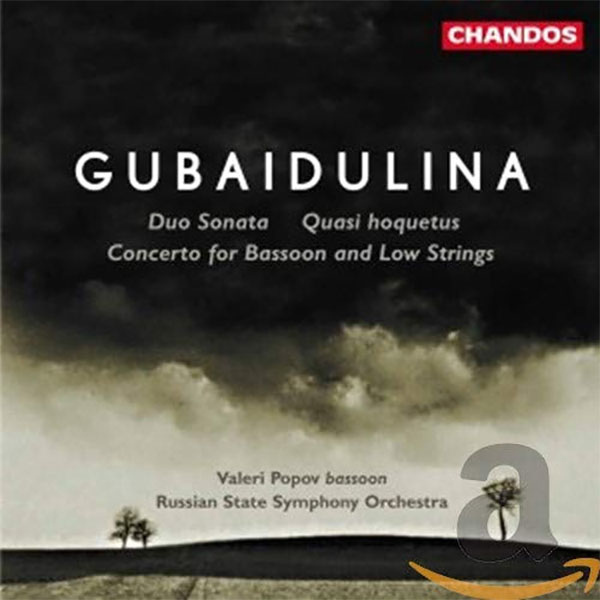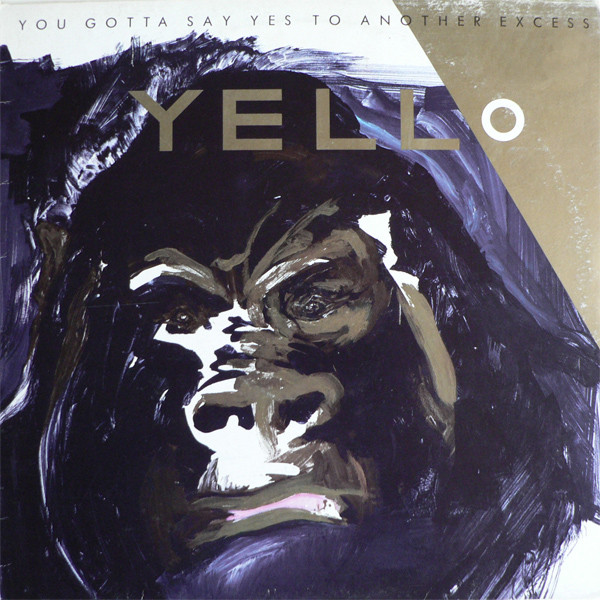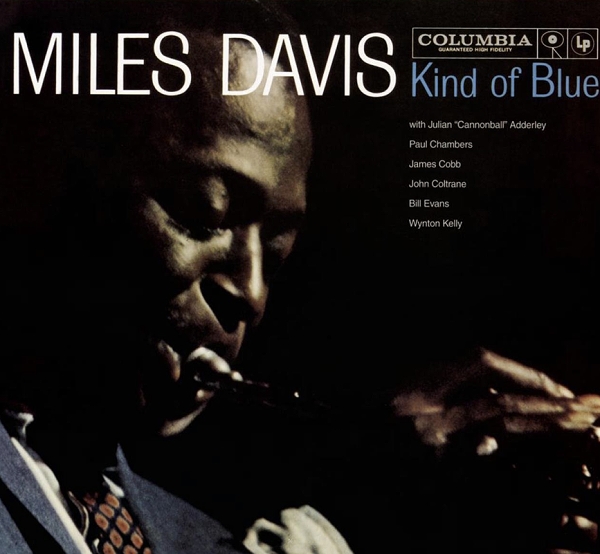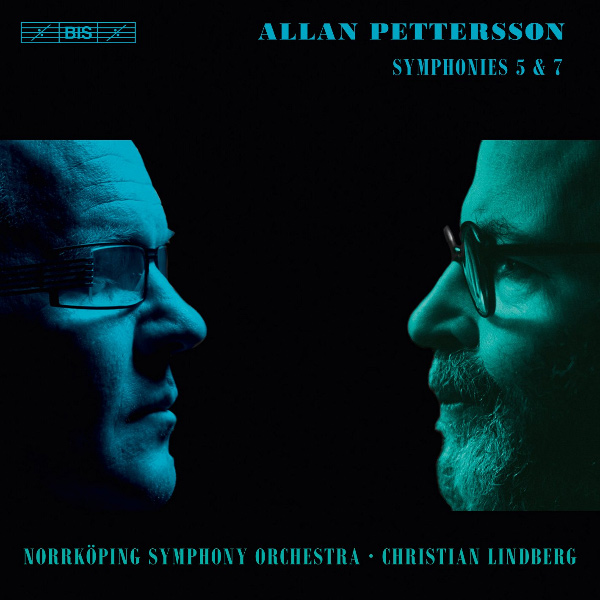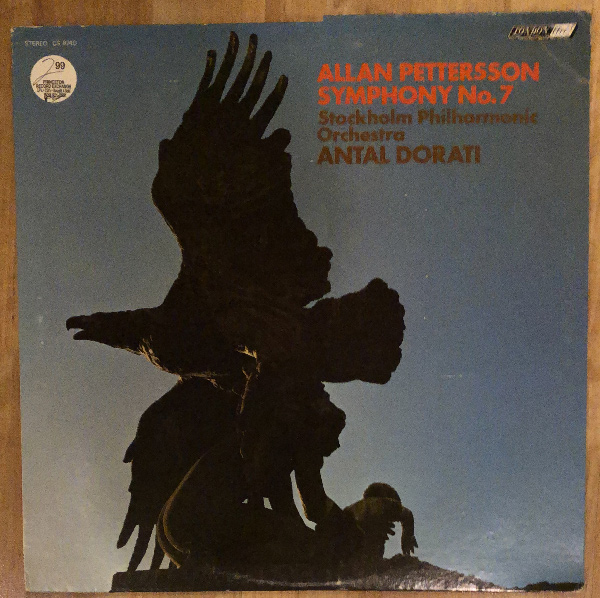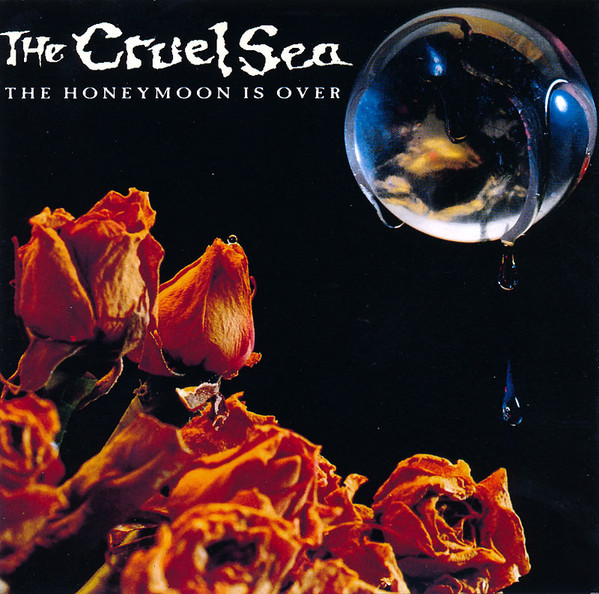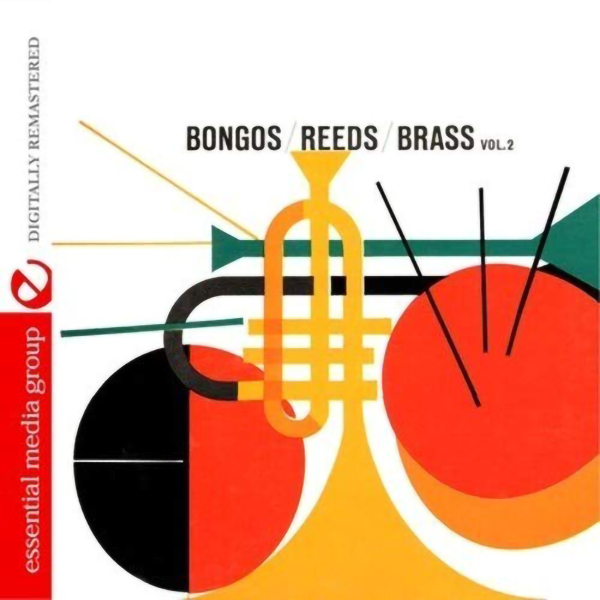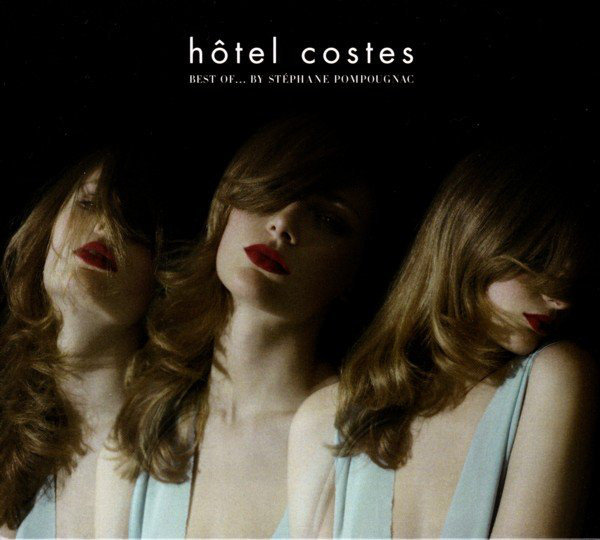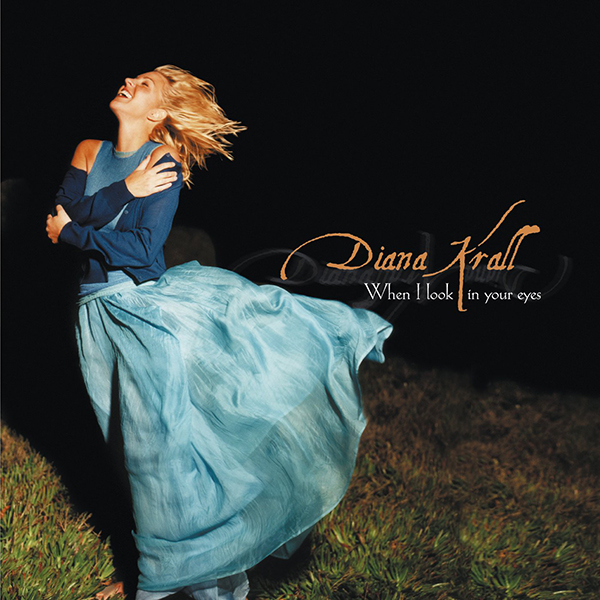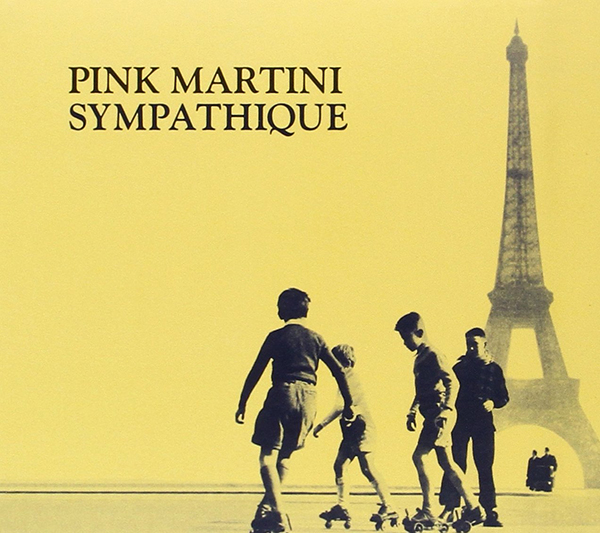Valeri Popov, Gubaidulina: Concerto for Bassoon & Low Strings – Bassoon Duo – Quasi hoquetus, Chandos Records, 1999, CD
As a musician, I’m always looking for new ways to challenge myself. In addition to performing as a freelancer, I want to expand my repertoire, whether it be a new concerto or a chamber work.
I recently decided to explore the three bassoon works from composer Sofia Gubaidulina. A contemporary of Shostakovich, she was at the forefront of experimental music in the sixties and seventies and today writes for film. Her latest credit is for Mary Queen of Scots from 2013.
In 1975, she collaborated with Russian bassoonist Valeri Popov to write Concerto for Bassoon and Low Strings. She followed this with Duo Sonata for Two Bassoons in 1977 and Quasi Hoquetus for bassoon, viola, and piano in 1984. All three works delve into extended techniques like multiphonics (multiple notes played at one time), flutter tongue, quarter tones, and resonance trills. It was part of a movement at the time to see just how far the woodwind technique could be stretched.
Researching the concerto brought me to Popov’s recording where he performs all three works. This CD has become the reference disc for anyone studying these pieces. And inevitably, any bassoonist hearing them will want to play them. Though some might consider it “bug music,” it is truly a perfect use of extended technique as a thing of beauty.
Today, modern composers have rediscovered tonality and melody and by comparison, Gubaidulina’s works seem ahead of their time. But I suspect this is because few other artists could use these techniques so effectively. They enhance the music without calling attention to themselves. She manages to incorporate them so that you can’t imagine the passage played any other way.
If you’re looking for an introduction to truly ground-breaking music, Popov’s CD is a great place to start. The Concerto is in actuality a chamber work with just four celli and three basses to accompany the bassoon solo. The Duo Sonata brings every extended technique to bear in 10 minutes’ time. In addition to quarter tones that cover the full range of the bassoon, it features 16 different multiphonics and two flutter-tongued sections. It also uses polyrhythm and dissonance in a completely logical and beautiful way. This recording will certainly stretch one’s belief about what’s possible on a woodwind instrument. Definitely check it out.
Don Cherry and Ed Blackwell, El Corazón, ECM Records 1230, 1982, CD
I believe that one of the essential elements of jazz music is humans talking to each other, communicating what’s on their minds through their instruments. And this requires honesty and mindfulness, which means that the musician’s life experiences are sure to be part of his or her conversation with the music and the other musicians making the music. I feel these things strongly when I listen to El Corazón, an album of collaboration between percussionist Ed Blackwell and multi-instrumentalist Don Cherry.
Don Cherry is primarily known for his pocket trumpet playing with free jazz pioneer Ornette Coleman. Ed Blackwell was behind the kit for quite a few of those Colemen sessions as well. So it’s fair to assume both men had grown quite accustomed to reading each other’s musical minds by the time they recorded El Corazón for ECM records in 1982 at Tonstudio Bauer in Ludwigsburg, Germany.
The playing is mostly an intimate conversation between just Cherry’s pocket trumpet and Blackwell’s drums, and, in typical ECM fashion, the soundstage is huge and the timbres are warm. There’s quite a bit of room echo on the instruments at times, and this lends an eerie timelessness to the playing. The moods are joyous, somber, thoughtful, and complicated. Just as conversations between friends often are.
Cherry, who had made a journey through Africa, utilizes such instruments as doussn’gouni (a simple stringed instrument with a wooden body and one to five strings) to bring African flavors to the conversations. He also plays piano, organ, and melodica on the album. And the kalimba, or thumb piano, is used to great effect as well.
Ed Blackwell, whose style fused African rhythms with New Orleans second-line and bebop, had a particular skill for keeping a swinging rhythm whether the music was fast or slow. And there was a lot of magic in his fingertips. His stick control and brushwork were very sophisticated and emotive. Blackwell could say a lot with brushes on a cymbal or a drum stick on a drum head, often getting a wide variety of tones and textures from a single cymbal or snare drum. Ed Blackwell had such command over percussion that he essentially used a drum kit as a melodic instrument, making him a true master. Ed Blackwell is a seriously under-appreciated musician, I believe. And as recordings of drums go, this one ranks very highly for me.
The third cut, “Makondi” is particularly rousing, and reminds me of Second Line marches with New Orleans brass bands. I find this humorous, because the next cut, is called “Street Dancing,” which is exactly what “Makondi” makes me want to do.
This album is well worth owning on CD or vinyl. As far as I can tell, it has not been given the high-resolution digital or 180g vinyl treatment that ECM has done for other albums in its catalog. Here’s hoping that happens soon.
I am grateful that these great craftsmen shared their Black experience and craft with us willing listeners. This album greatly opened my mind, and I hope it does the same for you.
Yello, You Gotta Say Yes To Another Excess, Elektra Records 60271-4, 1983, CD
Most folks already know the music of the band Yello, even if you don’t know their name. Their hit “Oh Yeah” was used to great effect in the movie Ferris Bueller’s Day Off in 1987 and became a timeless ear-worm. The song also earned a good $175M for band member Dieter Meier, too. Not bad money for singing a few syllables.
Yello’s primary members are singer Dieter Meier and sampler/synthesizer wizard Boris Blank. Their icy Euro-disco sound has been quite popular for the last few decades, and it is often used to demonstrate high-end systems at audio conventions. But what I think a lot of people don’t know about the “Oh Yeah” style of Yello is just how weird they used to be. And this album, You Gotta Say Yes To Another Excess, sits squarely between Yello’s early experimental music and later Euro-disco dance music.
This album was Yello’s third, and their first on a major label (Elektra in the US and Mercury in Europe). Before that Yello released two albums on Ralph Records, home to such weirdo visionaries as The Residents, Renaldo and The Loaf, and Snakefinger. And Yello fit right in with that crowd. Yello’s first two albums feature chunky dance beats built out of tape splices and primitive synthesizer rhythm, and all wrapped up with the band’s humor and knack for utilizing exotic and urban rhythms.
You Gotta Say Yes To Another Excess is a cleaner and slicker album, with greater studio effects than their previous two. This album also has its share of exotic and urban rhythms, and it’s just plain weird and fun. The opening cut, “I Love You” (whose video got some airplay on the music video channels) is built around a ridiculous-sounding sample of a car crash and a sample of a woman singing, um, “I love you.” And that’s just the beginning of the ride. There’s a lot of very deep synthesizer tones in the music, and you’ll give your system’s woofers a good workout. “No More Words” is a dance song so quirky it would make The Taking Heads itch all over. And, as best as I can tell, “Great Mission” describes a boat trip down the Amazon river with chirping birds and exotic marimba. It’s like a Martin Denny album smack dab in the middle of a techno album, but with narration by a deep-voiced magician. It’s followed by the title cut, which would fit right in on a Saturday night in a Cuban nightclub. And that’s followed by the cut “Swing,” which is almost a torchy ballad with synthesized tap dancing and narration in what I believe is Swiss German. Yeah, the whole thing is easier to listen to than describe. But it’s also a wonderland of synthesized music and textures, with sounds traveling all over the soundscape. It’s as though the music just can’t sit still.
The album was given a remastered and expanded edition on CD in 2005 for the UK, European, and Russian markets. If you’re looking for a good trip to get away from your troubles, this Yello album is just the ticket.
Jimmy Cobb – This I Dig of You, Smoke Sessions Records, 2019, 24/96 via Tidal
Jimmy Cobb was a jazz giant, drummer for other jazz giants of that era, and he died May 24, 2020, at the age of 91. He was the drummer on the album, Kind of Blue, which is the most famous jazz album of all time. It had Miles Davis on trumpet, Cannonball Adderly on alto sax, John Coltrane on tenor sax, Paul Chambers on bass, and Bill Evans on piano.
What a combination that was, and what an album! It was originally released on 8/17/1959. If you are a classic jazz fan, you must hear it (but you probably already have). It’s available on Tidal streaming. I have it on re-released vinyl and CD. The album shown above, This I Dig of You, is one I listened to this week, along with a Cannonball Adderley album, In Chicago, also released in 1959 (January 1) on which Cobb was the drummer. I was very fortunate to be able to hear these guys on my honeymoon in San Francisco, in 1968. I was a budding drummer myself in those days, and I would have given anything to sit in for a session.
Art Pepper, The Return of Art Pepper: The Complete Art Pepper Aladdin Recordings – Vol. 1, Blue Note Records, 1988, CD
Art Pepper is an alto sax jazz master whom I have referred to before. Here is an album I had not heard until I saw it on Tidal. It is entitled The Return of Art Pepper, released 5/11/1988 on CD. It has Chet Baker on piano and Shelly Manne on drums, both stars in their own right. One track has Joe Morello on drums.
Very nice. Most of the songs here were composed by Pepper. The album is sub-titled The Complete Art Pepper – Aladdin Recordings – Volume One, so I assume this is a compilation of some of his music from the 1950s.
Allan Pettersson The 7th Symphony Christian Lindberg conducting the Norrkoping Symphony Orchestra, Producer Hans Kipfer, Engineer Stephan Reh, BIS-2240 SACD released 2018 with symphony #5. High res download including multichannel
I cannot keep providing comforting music for the time we are living. This composition suggests to me what we are actually living through. The composer, Alan Pettersson wrote “I am not a composer. I am a voice crying out … that threatens to drown in the noise of the times.”
Pettersson is considered one of the greatest composers Sweden has produced. Sweden has produced many significant composers but none have the international reputation of Nielson, Sibelius, and Grieg in the other Nordic countries. Of the Swedish composers, I think he is among the top 3 and is regularly performed in Europe. Three complete symphony cycles have been recorded with many symphonies having 4 or 5 recorded performances. A video of the seventh symphony can be found on YouTube.
Born in 1911, Alan Pettersson’s father was a violent, alcoholic blacksmith. He grew up in a poor part of Stockholm. An early song cycle is titled Barefoot Songs. He made it to the conservatory of the Royal Swedish Academy of Music. He became a violist in the Royal Stockholm Philharmonic Orchestra. In 1951, he went to Paris to study composition with an extraordinary list of teachers; René Leibowitz, Arthur Honegger, Olivier Messiaen, and Darius Milhaud. His music sounds like none of them and is instantly recognizable. He returned to Sweden to compose.
In the early 1950’s he was diagnosed with the most severe form of rheumatoid arthritis for which no treatment existed at the time. He was granted a small disability pension but his living conditions were not good. He was confined to a fourth-floor apartment in a building with no elevator. “My material is my own life, the blessings, and the curses.”
His works are centered in tonality and he rejected the 12-tone method having studied it under René Leibowitz. His tonal language is dissonant and complex. The harmonic language extends beyond Shostakovich or Herrmann but not by such a stretch that the work cannot be understood. The works are his world as Mahler said of the symphony.
In the 7th Symphony, Pettersson introduced more approachable sections than his earlier symphonies mixed with his more difficult music. From the booklet “Restless passages with increasingly agitated ostinato motifs and violent eruptions are followed by untroubled and calm sections of lyrical melodic lines and romantic harmonies.” For the first time, he experienced success. At the conclusion of the premiere, he was called to the stage with standing ovations four times. It was the last time he was able to personally attend a premiere of one of his symphonies. The orchestra took the work on tour.
The 7th premier performance with Antal Dorati and the Stockholm Philharmonic was released on a Swedish label but with worldwide acclaim, it jumped to London (Decca) in 1972 (photo above) and is still available on a CD.
His illness progressed and he could no longer write yet he continued. His fame had grown to the point that his 8th symphony was performed by the Chicago Symphony. His health continued to decline but he still produced his 9th symphony before a 9-month hospital stay where he sketched out two more symphonies.
He would go on to write 16 and start a 17th before he died in 1980. Three DVDs on his life were produced and each is included with 3 CDs of a BIS symphony cycle but no DVD comes with the 7th symphony.
Pettersson’s 7th is one of the great works of the second half of the twenty century, written in 1966 – 1967. The piece is in one movement but it is clearly in sections. It is a true symphony with unifying thematic, motivic, and harmonic aspects.
For the recording, I recommend the one where the producer divides the work into 13 tracks marked with bar numbers in the score. That CDs photo and performance information is at the top of the review. Released in 2018 this is the 5th recording of this work. Critics have struggled with other recordings to outline the huge interweaving contrasts using timings on the CD player as the single movement moves forward. This SACD solves that problem but it is important to remember these are the producer’s demarcations and not the composer’s.
The booklet is skimpy and does not go into track-by-track detail. I present a feeble attempt to give impressions of the tracks. The piece begins with agitated music that introduces the motivic and rhythmic figures that will appear across the journey of the work. At track 2 things have turned increasingly sinister and dissonant but it collapses to more tonal passages in the strings then regains harsh energy again and screams at the end. At track 3 the score becomes less complex but it is moving to the longest raw distant climax with significant percussion in a style unique to Pettersson.
At track 4 Pettersson brings things down again but an ominous ostinato is in the lower brass and it builds to another painful scream.
In track 5 we reach more lyrical sections in the strings with a richer harmonic background but they are cut short by the brass and the score then oscillates between string and brass a couple more times. Track 6 puts track 5 on steroids with harsher and louder brass shifting back and forth with tortured tonal string writing. The dark forces explode and tonality evaporates at Track 7. In Track 8 the music appears to question what has just happened.
At track 9 one of the most amazing things happens in all music. Some sun comes out and we are presented a tender slow sad tuning in the strings with rich harmonic part-writing. We were given hints of this on track 5. This 5-minute section on its own would move almost any listener. In Pettersson’s symphony, this is called a lyric island. Track 9 could be broken off on its own and make it to the radio but the pain we have suffered to get to this point is lost if track 9 is isolated.
At the start of track 10, a storm is on the horizon but not yet arrived. The storm is huge but does not last as long as those that have come before. Track 11 hints the storm has passed south but more tortured music returns. At Track 12 soft music again questions what has just happened before a final short outburst. Track 13 returns to material from the opening and a strange lyric earworm like theme appears in the high strings. The music ends softly after that but provides no resolution. “Bleak, dark and beautiful all at the same time”
Another review thinks it reflects a 1968 quote of the composer “When will the angel come who restores the song to the soul, so simply and clearly, that a child will cease it’s weeping?”
A warning that not all streaming sites have the track divisions for reasons I do not understand. The work may be more approachable if you skip tracks 3, 4, and 7 in the first couple of listens.
Henryk Gorecki: Symphony No. 3 (Symphony Of Sorrowful Songs), Dawn Upshaw soprano with the London Sinfonietta conducted by David Zinman, Elektra Nonesuch Records, ASIN: B000005J1C
And an alternative view, best for those new to classical music:
Beth Gibbon soprano, The Polish National Radio Symphony Orchestra conducted by Krzysztof Penderecki, Domino, ASIN: B07N43N948 for CD and B07NBDQX2B for the LP. Also high res download.
This another consoling piece in the time of COVID. The Polish composer Henryk Gorecki, took the avant-garde approach to his works in the 50s and 60s. This tonal work came out of the blue. It is three long slow movements “austerely plaintive, emotionally direct and steeped in medieval modes”. The songs are in Polish but it is best to just take it in as absolute music and not worry about the words.
At its premiere at a French new music festival in 1977 Pierre Boulez, the leader of the avant-garde, post World War II atonal composers, is said to have shouted an expletive. It turns out to have been the most radical work at the festival marking a return to tonality and the decline of the avant-garde atonal composers. Wikipedia has a huge article devoted to the work and I have no space in this short overview but I will give some personal encounters with the work.
A recording of the premiere got some airplay on WNYC in New York. The program was Tim Page’s New Old and Unexpected with Tim Page, later to become a world-famous critic and musicologist. I heard it, liked it and taped it. Acquiring the LP required a purchase from Europe, not something I did a kid. This memory only goes so far back, I was not sure if this was really the way I encountered this music but a publication at USC Southern California confirms it.
The work remained virtually unknown in the US with the CDs reissues about as hard to find as the vinyl but it never disappeared in live performances. In 1992 Nonesuch records producer Robert Hurwitz heard a live performance and decided to record it with the well-known soprano Dawn Upshaw. David Zinman conducted the London Sinfonietta. Hurwitz thought it might do 25000 copies which was large for a classical CD release at the time. It sold over a million. What happened is in this New York Times article.
It now has 18 recordings. Gorecki saw royalty checks in the six figures but did not cash them. He did not want this type of fame for one work. He was not able to write many new compositions after this occurred in 1992. People wanted another work like it but he had moved past this as soon as the ink was dry 15 years earlier. The 4th symphony, his final work, innovative as ever, is clearly Gorecki for those who know many of his works but it has no relationship to the 3rd.
Soprano Stefania Woytowicz owned this work for 10 years from the premiere. She performs in three recordings, including the premiere. The first at 60 minutes but another is only 45 minutes. The time difference is amazingly not that noticeable. Most of us who learned the work early tend to stay with Woytowicz. After the Upshaw version, another Pole, Zofia Kilanowicz recorded it 3 times, in quick succession including one for Naxos and then labels piled in.
Gorecki was said to have written it for a soprano with Upshaw’s lighter voice and not the larger darker voice of Woytowicz but I cannot find the source for that claim at the moment. For those who are already regular listeners to classical music, I recommend the Upshaw as a place to start and have listed it above.
As an alternative, I am recommending a recording with Beth Gibbons to those of you not likely to be interested in a 50-minute vocal symphony. This is the latest version. She is not classically trained and sings closely into the microphone like a pop singer. She is part of the group Portishead. The work pushes her vocal technique to its limits. She loved it so much she wanted to perform and record it. The New York Times has a large article with more details on how it came about.
This is not some sort of crossover album. The conductor is the late Krzysztof Penderecki who was perhaps the greatest Polish composer of the late 20th century, as well as an international conductor. He would not have taken on this project if he did not believe in it’s validly. It is best streamed first. This is not the first attempt at using a non-traditional vocalist. Wikipedia notes in 2012 Sony did it with Lisa Gerrard but that does appear to be a crossover attempt. It is the traditional classical reading of Upshaw that drew a million listeners for this and lightning does not strike twice.
The Cruel Sea, The Honeymoon is Over, Red Eye Records, 1993, CD
From the Cruel Sea’s CD, “The Honeymoon Is Over,” comes the lead track “Orleans Stomp.” This one starts out with some bass and percussion, and when the guitar comes in, the funk is boiling. Like a book with a real hook for the first chapter, the lead track promises a bit more than the rest of the disc can provide, but “Orleans Stomp” is worth hearing.
The Harry Zimmerman Big Band, Bongos / Reeds / Brass Vol. II, HiFi Records, 1961, CD
From the Harry Zimmerman Big Band’s CD “Bongos / Reeds / Brass II” comes the excellent cut “Orchids in the Moonlight.” The opening cymbal brushwork should be crisp and clear and sound plainly like the bronze of the cymbal – not an undifferentiated hiss. When the brass cuts in, there should be a visceral grunt. This is WELL recorded!
Stephane Pompougnac, The Best of Hotel Costes, Pschent Music, 2004, CD
This interesting gem that my better half labels “Weird” includes the track, “One Night in Rio,” by Louie Austin. The “song” is mostly spoken with a mocking “echo chorus.” The sound effects (ice cubes, screams, and airplane engines, among others) serve as the backdrop for Mr. Austin’s whiney voice. And despite all this, the song just works. Pretty much a fun “must-hear.”
Diana Krall, When I Look Into Your Eyes, Verve Records, 1999, CD
Diana is an acquired taste – you either love her or you hate her. I started in the latter group, but have, over time, come to appreciate her – or at least to tolerate her. I’m still not in the fan club, but when I hear a song like “Let’s Face the Music and Dance,” I’m smitten. It’s “soft jazz,” and my disdain for the category is strong, but occasionally you catch a fish, even in a cesspool. This song is a fish.
Pink Martini, Sympathique, Heinz Records, 1997, CD
The versatile Pink Martini, playing in a variety of styles, languages, and instrument combinations, is startlingly well-recorded, and absolutely perfect in each of their offerings on this amazing CD. All but three of the tracks on this disc have ended up in my “favorites” list. I listen to these, again and again, appreciating their rhythm, harmony, and style. I just happened to run into Pink Martini on YouTube, and have since set about collecting all their music. Many of these are “demonstration quality” and I use them to wow friends who want to hear my system. What fun!



